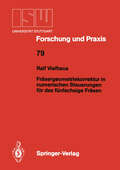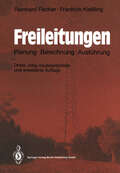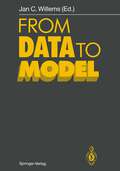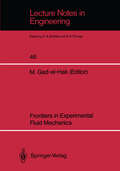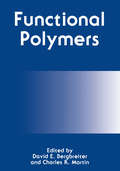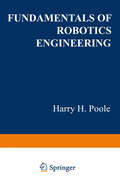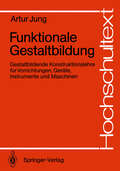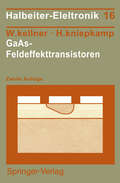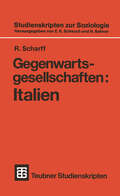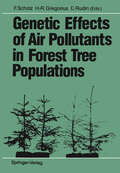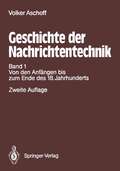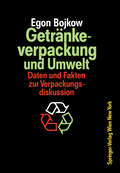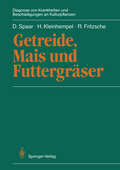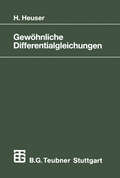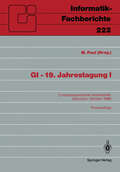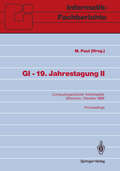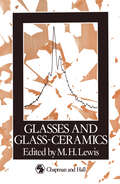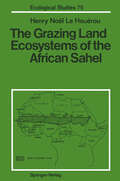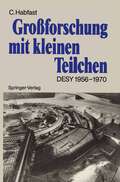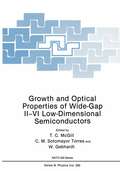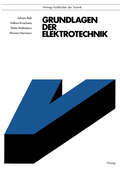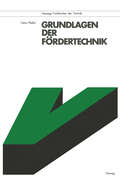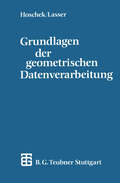- Table View
- List View
Fräsergeometriekorrektur in numerischen Steuerungen für das fünfachsige Fräsen (ISW Forschung und Praxis #79)
by Ralf ViefhausFreileitungen: Planung, Berechnung, Ausführung
by Reinhard Fischer Friedrich KießlingBei Freileitungen hat sich in den letzten Jahren ein vielfältiger Wandel vollzogen, der bisher in der Literatur noch nicht zusammenfassend dokumentiert ist. So wurden die einschlägigen Normen und Vorschriften völlig neu gestaltet und die SI-Einheiten eingeführt. Die Möglichkeiten der Datenverarbeitung haben sich erweitert und können zunehmend für die Optimierung genutzt werden. Bei Lastannahmen für Tragwerke, bei Leiterschwingungen, bei der Ausführung der Leiter, der Armaturen und der Isolatoren liegen neue Erkenntnisse vor, neue Bauformen wurden geschaffen. Die Methoden der Montage haben sich ebenso gewandelt. Der Einfluß der Umwelt auf die Gestaltung von Freileitungen hat zugenommen. Ziel des Buches ist, die dem heutigen Stand der verfügbaren Hilfsmittel entsprechenden Planungs- und Berechnungsmethoden darzustellen, die weiterführende Literatur aufzulisten und die Leitungsbaupraxis mit besonderer Berücksichtigung der Bundesrepublik Deutschland zu schildern. Von der vorherigen Auflage unterscheidet es sich durch eine völlige Neubearbeitung und Neugestaltung des Textes mit Rücksicht auf neuere Erkenntnisse und neuere Literatur, durch erweiterten Inhalt und verbesserte Darstellung sowie das Eingehen auf die gewandelte Leitungsbaupraxis.
From Data to Model
by Jan C. WillemsThe problem of obtaining dynamical models directly from an observed time-series occurs in many fields of application. There are a number of possible approaches to this problem. In this volume a number of such points of view are exposed: the statistical time series approach, a theory of guaranted performance, and finally a deterministic approximation approach. This volume is an out-growth of a number of get-togethers sponsered by the Systems and Decision Sciences group of the International Institute of Applied Systems Analysis (IIASA) in Laxenburg, Austria. The hospitality and support of this organization is gratefully acknowledged. Jan Willems Groningen, the Netherlands May 1989 TABLE OF CONTENTS Linear System Identification- A Survey page 1 M. Deistler A Tutorial on Hankel-Norm Approximation 26 K. Glover A Deterministic Approach to Approximate Modelling 49 C. Heij and J. C. Willems Identification - a Theory of Guaranteed Estimates 135 A. B. Kurzhanski Statistical Aspects of Model Selection 215 R. Shibata Index 241 Addresses of Authors 246 LINEAR SYSTEM IDENTIFICATION· A SURVEY M. DEISTLER Abstract In this paper we give an introductory survey on the theory of identification of (in general MIMO) linear systems from (discrete) time series data. The main parts are: Structure theory for linear systems, asymptotic properties of maximum likelihood type estimators, estimation of the dynamic specification by methods based on information criteria and finally, extensions and alternative approaches such as identification of unstable systems and errors-in-variables. Keywords Linear systems, parametrization, maximum likelihood estimation, information criteria, errors-in-variables.
Frontiers in Experimental Fluid Mechanics (Lecture Notes in Engineering #46)
by Mohamed Gad-El-HakDynamical systems theory and flow control are two research areas of great current interest. These and other special situations are among the topics covered in this volume. Each article emphasizes the use of experiments to achieve better physical understanding of a particular class of flow problems. The topics covered were chosen because of their importance to the field, recent appeal, and potential for future development. The articles are comprehensive and coverage is pedagogical with a bias towards recent developments.
Functional Morphology of Feeding and Grooming in Crustacea
by Bruce E. Felgenhauer Anne. B Thistle L. WatlingAbetted by recent technological advances in scanning and transmission electron microscopy, as well as new preparative methods, these contributions examine crustacean anatomy, demonstrating (or at least inferring) the functions of morphological features. In addition to feeding and grooming, they also
Functional Morphology of Feeding and Grooming in Crustacea
by Bruce E. Felgenhauer Anne. B Thistle L. WatlingAbetted by recent technological advances in scanning and transmission electron microscopy, as well as new preparative methods, these contributions examine crustacean anatomy, demonstrating (or at least inferring) the functions of morphological features. In addition to feeding and grooming, they also
Functional Polymers
by David E. Bergbreiter R. MartinThis monograph contains manuscripts, poster abstracts and summary statements representing the contributions of a group of scientists who participated in the sixth annual Texas A&M Industry-University Cooperative Chemistry Program (IUCCP) at Texas A&M University in College Station, Texas, March 22-24, 1988. This symposium on "Functional Polymers" was organized by a university-industrial steering committee consisting of Dr. D. Keene, Hoechst Celanese; Dr. D. E. McLemore, Dow Chemical Company; Dr. B. Frushour, Monsanto Company; Dr. S. Corley, Shell Development; Dr. F. Hoffstadt, BPAmerica; Dr. D. E. Bergbreiter, Texas A&M University; Dr. C. A. J. Hoeve, Texas A&M University; Dr. C. R. Martin, Texas A&M University; Dr. A. Clearfield, Texas A&M University; and Dr. A. E. Martell, Texas A&M University. The symposium itself was generously supported by the industrial companies participating in the IUCCP program. These sponsoring chemical companies include; Shell Development Company, Dow Chemical Company, BPAmerica, Monsato Company and Hoechst Celanese. The choice of "Functional Polymers" as the subject for this symposium reflects the rapid developments occurring in the broad field of polymer science and the potential for using polymeric derivatives in many new exciting and potentially profitable applications. The invited papers and submitted posters reflect the diversity of this field and include many different topics ranging from biomedical applications of polymers to conducting polymers to use of polymers as lithographic masks and recording media. General topics included in the symposium were: photoresponsive polymers, polymer blends, electronically conductive polymers, polymers catalysts, biomedical polymers and membrane transport and permeability.
Fundamentals of Robotics Engineering
by Harry H. PooleRobotics engineering has progressed from an infant industry in 1961 to one including over 500 robot and allied firms around the world in 1989. During this growth period, many robotics books have been published, so me of which have served as industry standards. Until recently, the design of robotics sys tems has been primarily the responsibility of the mechanical engineer, and their application in factories has been the responsibility of the manufacturing engineer. Few robotics books address the many systems issues facing electron ics engineers or computer programmers. The mid-1980s witnessed a major change in the robotics field. The develop ment of advanced sensor systems (particularly vision), improvements in the intelligence area, and the desire to integrate groups of robots working together in local work cells or in factory-wide systems have greatly increased the partic ipation of electronics engineers and computer programmers. Further, as ro bots ga in mobility, they are being used in completely new areas, such as construction, firefighting, and underwater exploration, and the need for com puters and smart sensors has increased. Fundamentals af Rabaties Engineering is aimed at the practicing electrical engineer or computer analyst who needs to review the fundamentals of engi neering as applied to robotics and to understand the impact on system design caused by constraints unique to robotics. Because there are many good texts covering mechanical engineering topics, this book is limited to an overview of those topics and the effects they have on electrical design and system pro grams.
Funktionale Gestaltbildung: Gestaltbildende Konstruktionslehre für Vorrichtungen, Geräte, Instrumente und Maschinen (Hochschultext)
by Artur JungDieses Buch behandelt den konstruktiven Entwurfsvorgang, wie er sich in der Praxis in vielen Fällen darstellt, in einem vernetzten Ablaufmodell (Drei-Ebenen-Modell). Damit ergänzt es die heute üblichen Ablaufpläne und versucht, den schwierigen Vorgang der Gestaltbildung technischer Produkte aus Vorstellungen über ihre Funktionen erfaßbar zu machen. Zur Synthese und Analyse des Konstruktionsprozesses werden die Begriffe "Geometrie-Funktionsprinzip" und "Gestaltfunktion" eingeführt und an Beispielen erläutert. Das besondere Anliegen des Autors ist dabei, die geometrisch-funktionale Denkweise, die ein Konstrukteur meist unbewußt praktiziert, für den Studierenden didaktisch aufzubereiten, übergreifende Aspekte sichtbar und für den Gestaltungsvorgang nutzbar zu machen. Die behandelten Beispiele reichen von einfachen Vorrichtungen über Präzisionsinstrumente bis hin zu den genau arbeitenden Maschinen der Feinwerktechnik.
GaAs-Feldeffekttransistoren (Halbleiter-Elektronik #16)
by Walter Kellner Hermann KniepkampAus den Besprechungen: "...Das Buch wendet sich an Ingenieure, Naturwissenschaftler und Studenten, die sich in die Herstellungstechnik und Eigenschaften dieser neuen Bauelemente einarbeiten wollen. Auf Grund der hohen Bedeutung dieser Technik wurde ihr ein eigener Band in der bekannten und bereits an dieser Stelle diskutierten Reihe Halbleiter-Elektronik gewidmet. Vorausgesetzt wird die Kenntnis der Grundlagen der Halbleiter-Elektronik. Die Verfasser sind kompetente Fachleute aus der zentralen Forschung und Entwicklung der Siemens AG München ... Besonders wertvoll ist ein umfangreiches, nach den Kapiteln gegliedertes Literaturverzeichnis, das eine breite Übersicht über das Quellenmaterial und Zusatzliteratur gibt." Elektropraktiker#1 "...Nicht ohne Erfolg haben sich die beiden Autoren die Mühe gegeben, ein Buch zu schreiben, welches sowohl für "alte Hasen" als auch für Studenten geeignet ist. So können z.B. diejenigen, welche über ausreichende Grundlagenkenntnisse verfügen, die zwei ersten Kapitel überspringen, während angehende Wissenschaftler und Ingenieure gerade hier interessante und nützliche Denkanstöße finden werden..." Elektronik#2
Genetic Effects of Air Pollutants in Forest Tree Populations: Proceedings of the Joint Meeting of the IUFRO Working Parties Genetic Aspects of Air Pollution Population and Ecological Genetics Biochemical Genetics held in Großhansdorf, August 3–7, 1987
by Florian Scholz Hans-Rolf Gregorius Dag RudinAir pollutants provide environmental conditions that drastically differ in many respects from those to which forest trees are naturally adapted. Leading experts in the field here consider these questions of immediate relevance arising from the changing environment: (1) Do air pollutants introduce effects of selection that differ from those known for populations that are not subject to such stress conditions? (2) If air pollutants introduce quantitatively or even qualitatively novel selective effects, which consequences might arise from the adaptation of forest tree populations to the present conditions as well as for the preservation of adaptability to future conditions? In addition to these questions, concepts for preservation of genetic resources are discussed.
Geschichte der Nachrichtentechnik: Band 1 Beiträge zur Geschichte der Nachrichtentechnik von ihren Anfängen bis zum Ende des 18. Jahrhunderts
by Volker AschoffGetränkeverpackung und Umwelt: Auswirkungen der Verpackung von Getränken und flüssigen Molkereiprodukten auf die Umwelt Daten und Fakten zur Verpackungsdiskussion
by Egon BojkowGetreide, Mais und Futtergräser (Diagnose von Krankheiten und Beschädigungen an Kulturpflanzen)
by Dieter Spaar Helmut Kleinhempel Rolf FritzscheGewöhnliche Differentialgleichungen: Einführung in Lehre und Gebrauch (Mathematische Leitfäden)
by Harro HeuserDieses Buch ist aus Vorlesungen und Übungen entstanden, die ich mehrfach an der Universität Karlsruhe für Mathematiker, Physiker, Ingenieure und Informati ker gehalten habe. Es ist so geschrieben, daß es zum Selbststudium dienen kann: Die Gedankengänge sind ausgiebig motiviert, die Beweise detailliert, und an durchgerechneten Beispielen und gelösten Aufgaben herrscht kein Mangel. Bei der Abfassung schwebte mir vor, nicht nur ein theoretisches Gerüst aufzubau en, sondern auch eine Brücke zu den Anwendungen zu schlagen. Damit wollte ich zweierlei erreichen: erstens wollte ich ganz nüchtern und pragmatisch den Stu denten der Mathematik auf seine spätere Zusammenarbeit mit Naturwissenschaft lern und Ingenieuren einstimmen und im gleichen Atemzug auch dem "Anwen der" den Zugang zu den Differentialgleichungen erleichtern. Zweitens wollte ich - weniger nüchtern und weniger pragmatisch - den Leser auf etwas hinweisen, das zu den Wundern und Kraftquellen unserer Kultur gehört: auf die Tatsache, daß "reines" Denken, "Hirn-Gespinst" - eben Mathematik - die reale Welt nach zeichnen und umgestalten kann. Das Staunen hierüber hat denn auch alle Philo sophen ergriffen, die nicht bloß Schwadroneure waren. Und noch Einstein fragte verwundert: "Wie ist es möglich, daß die Mathematik, letztlich doch ein Produkt menschlichen Denkens, unabhängig von der Erfahrung, den wirklichen Gegeben heiten so wunderbar entspricht?" Die wissenschaftliche Revolution, die uns noch immer treibt und drängt und drückt, diese sehr revolutionäre Revolution, hat im 17. Jahrhundert begonnen, und ihre Bastillestürmer waren "Hirngespinste" par ex cellence: Newtonsche Fluxionen und Leibnizsche Differentiale.
GI — 19. Jahrestagung I: Computergestützter Arbeitsplatz München, 18.–20. Oktober 1989 Proceedings (Informatik-Fachberichte #222)
by M. PaulDie in den vergangenen Jahren außerordentlich gesteigerte Leistungsfähigkeit sowohl der Arbeitsplatzrechner als auch der Kommunikationstechnik für ihre Vernetzung erschließen sinnvolle Anwendungsmöglichkeiten für immer weitere und umfangreichere Arbeitsbereiche. Die 19. Jahrestagung der GI greift wichtige Fragen hierzu auf und setzt sich mit einer Fülle von Einzelthemen auseinander. Dabei wendet sie sich gleichermaßen an Entwickler, Anwender, Wissenschaftler und Studenten.
GI — 19. Jahrestagung II: Computergestützter Arbeitsplatz München, 18.–20. Oktober 1989 (Informatik-Fachberichte #223)
by M. PaulDie in den vergangenen Jahren außerordentlich gesteigerte Leistungsfähigkeit sowohl der Arbeitsplatzrechner als auch der Kommunikationstechnik für ihre Vernetzung erschließen sinnvolle Anwendungsmöglichkeiten für immer weitere und umfangreichere Arbeitsbereiche. Die 19. Jahrestagung der GI greift wichtige Fragen hierzu auf und setzt sich mit einer Fülle von Einzelthemen auseinander. Dabei wendet sie sich gleichermaßen an Entwickler, Anwender, Wissenschaftler und Studenten.
Glasses and Glass-Ceramics
by M. H. LewisThe emergence of synthetic ceramics as a prominent class of materials with a unique combination of properties has been an important part of the materials-science scene over the past 20 years. These 'high-technology' ceramics have varied applications in areas utilizing their exceptional mechanical, thermal, optical, magnetic or electronic properties. A notable development of the 1970s was that of 'Si-based' ceramics (Si3N4' SiC and 'Sialons') as high-temperature engineering solids. More recently the zirconia-based ceramics have evolved as a class of material with significant improvements in fracture-toughness. In the 1980s we are on the threshold of development of ceramic-matrix composites with the promise of over coming major limitations in engineering design with 'brittle' ceramics and the development of novel properties unattainable with monolithic micro structures. Throughout this period there have been significant but less well-publicized developments in the field of glass-ceramics and glasses. It is the purpose of this publication to review selected topics within this important area of materials science. A key element in understanding the relation between properties and microstructure is a knowledge of atomic arrangement in ceramic phases. Recent developments in NMR and X-ray absorption spectroscopies have had considerable impact on studies of atomic co-ordination in glasses and crystalline ceramic materials and are reviewed in Chapters 1 and 2. Glass-ceramics are derived from the parent glasses by controlled crystal lization and have properties dictated, in part, by the efficiency of crystal nucleation within the glass volume.
The Grazing Land Ecosystems of the African Sahel (Ecological Studies #75)
by Henry N. Le Houerou7. 2 The Pilot Zone of the FerIo . . . . . . . . . . . . . . . . . . . . . . . . . . . . . . . . . . . 157 7. 2. 1 Geographical Zoning and Administrative Setup. . . . . . . . . . . . . 157 7. 2. 2 Climate . . . . . . . . . . . . . . . . . . . . . . . . . . . . . . . . . . . . . . . . . . . . . . . 158 7. 2. 3 The Substratum. . . . . . . . . . . . . . . . . . . . . . . . . . . . . . . . . . . . . . . . 161 7. 2. 4 Surface Water. . . . . . . . . . . . . . . . . . . . . . . . . . . . . . . . . . . . . . . . . . 166 7. 2. 5 Vegetation and Rangelands . . . . . . . . . . . . . . . . . . . . . . . . . . . . . . 166 7. 2. 6 Wildlife. . . . . . . . . . . . . . . . . . . . . . . . . . . . . . . . . . . . . . . . . . . . . . . 168 7. 2. 7 Livestock. . . . . . . . . . . . . . . . . . . . . . . . . . . . . . . . . . . . . . . . . . . . . . 168 7. 2. 8 Evolution of Land Use and History of Development . . . . . . . . 170 7. 3 Monitoring . . . . . . . . . . . . . . . . . . . . . . . . . . . . . . . . . . . . . . . . . . . . . . . . . . 181 7. 3. 1 Principles, Problems and Methods . . . . . . . . . . . . . . . . . . . . . . . . 181 7. 3. 2 Evaluation of Green Herbaceous Biomass by Orbital Remote Sensing . . . . . . . . . . . . . . . . . . . . . . . . . . . . . . . . . . . . . . . . . . . . . . . 188 7. 3. 3 Evaluation of Range Production from Ground Sampling . . . . 207 7. 3. 4 Low Altitude Systematic Reconnaissance Flights (SRF) . . . . . . 211 7. 3. 5 Practical Results . . . . . . . . . . . . . . . . . . . . . . . . . . . . . . . . . . . . . . . 215 7. 4 Conclusions on Monitoring . . . . . . . . . . . . . . . . . . . . . . . . . . . . . . . . . . . . 233 8 General Conclusions: Towards an Ecological Management of the Sahelian Ecosystems . . . . . . . . . . . . . . . . . . . . . . . . . . . . . . . . . . . . . . . . . . 237 References . . . . . . . . . . . . . . . . . . . . . . . . . . . . . . . . . . . . . . . . . . . . . . . . . . . . . . 241 Subject Index . . . . . . . . . . . . . . . . . . . . . . . . . . . . . . . . . . . . . . . . . . . . . . . . . . . 269 of Scientific Names. . . . . . . . . . . . . . . . . . . . . . . . . . . . . 275 . . . . . . . . . . . . Index Animals . . . . . . . . . . . . . . . . . . . . . . . . . . . . . . . . . . . . . . . . . . . . . . . . . . . . . 275 Plants . . . . . . . . . . . . . . . . . . . . . . . . . . . . . . . . . . . . . . . . . . . . . . . . . . . . . . 277 VII Abbreviations and Acronyms AVHRR Advanced Very High Resolution Radiometer CILSS Comite Inter-Etats de Lutte contre la Secheresse au Sahel CIPEA Centre International pour l'Elevage en Afrique CNRS Centre National de la Recherche Scientifique CP Crude Protein (N x 6.
Großforschung mit kleinen Teilchen: Das Deutsche Elektronen-Synchrotron DESY 1956–1970
by Claus HabfastDas Deutsche Elektronensynchrotron (DESY) in Hamburg ist international eines der erfolgreichsten Laboratorien für Teilchenphysik. Es gehört zu den in der Öffentlichkeit bekanntesten Großforschungseinrichtungen der Bundesrepublik. Claus Habfast, selbst ein erfahrener Teilchenphysiker, beschreibt hier im Rahmen einer großangelegten Studie zur Geschichte der Deutschen Großforschung die Ursprünge von DESY im Jahre 1956 bis zu seiner endgültigen internationalen Etablierung in den frühen 70er Jahren. Dem Autor standen für seine Vorarbeiten sowohl das Archiv der Forschungseinrichtung als auch staatliche Archive zur Verfügung. Darüber hinaus wurden Laborberichte und Fachliteratur, sowie private Quellen, herangezogen, so daß eine detaillierte und facettenreiche Beschreibung entstanden ist. Für den Historiker eröffnet das Werk umfangreiches, bisher unerschlossenes Quellenmaterial. Das Buch richtet sich an alle, die an der Teilchenphysik und dem Entstehen des Großlabors DESY, sowie an der Wissenschaftspolitik in der Bundesrepublik Deutschland, interessiert sind.
Growth and Optical Properties of Wide-Gap II–VI Low-Dimensional Semiconductors (Nato Science Series B: #200)
by T. C. McGill C. M. Sotomayor Torres W. GebhardtThis volume contains the Proceedings of the NATO Advanced Research Workshop on "Growth and Optical Properties of Wide Gap II-VI Low Dimensional Semiconductors", held from 2 - 6 August 1988 in Regensburg, Federal Republic of Germany, under the auspices of the NATO International Scientific Exchange Programme. Semiconducting compounds formed by combining an element from column II of the periodic table with an element from column VI (so called II-VI Semiconductors) have long promised many optoelectronic devices operating in the visible region of the spectrum. However, these materials have encountered numerous problems including: large number of defects and difficulties in obtaining p- and n-type doping. Advances in new methods of material preparation may hold the key to unlocking the unfulfilled promises. During the workshop a full session was taken up covering the prospects for wide-gap II-VI Semiconductor devices, particularly light emitting ones. The growth of bulk materials was reviewed with the view of considering II-VI substrates for the novel epitaxial techniques such as MOCVD, MBE, ALE, MOMBE and ALE-MBE. The controlled introduction of impurities during non-equilibrium growth to provide control of the doping type and conductivity was emphasized.
Grundlagen der Elektrotechnik (Viewegs Fachbücher der Technik)
by Johann Reth Hellmut Kruschwitz Dieter Müllenborn Klemens HerrmannDieses Lehr- und Arbeitsbuch vermittelt das Lehrgebiet ausführlich und praxisnah, unterstützt den Lernerfolg durch die leichte verständliche Darstellung, enthält viele Merksätze, Lehrbeispiele und Übungsaufgaben mit Lösungen als Lernhilfe, veranschaulicht den Inhalt in fast 600 Bildern, Tafeln, Skizzen und Diagrammen.Physikalische Größen und ihre Einheiten sind auf das Internationale Einheitensystem (SI) abgestimmt. Formelzeichen, Betriebsmittelkennzeichnungen und Schaltsymbole entsprechen den DIN-Empfehlungen.
